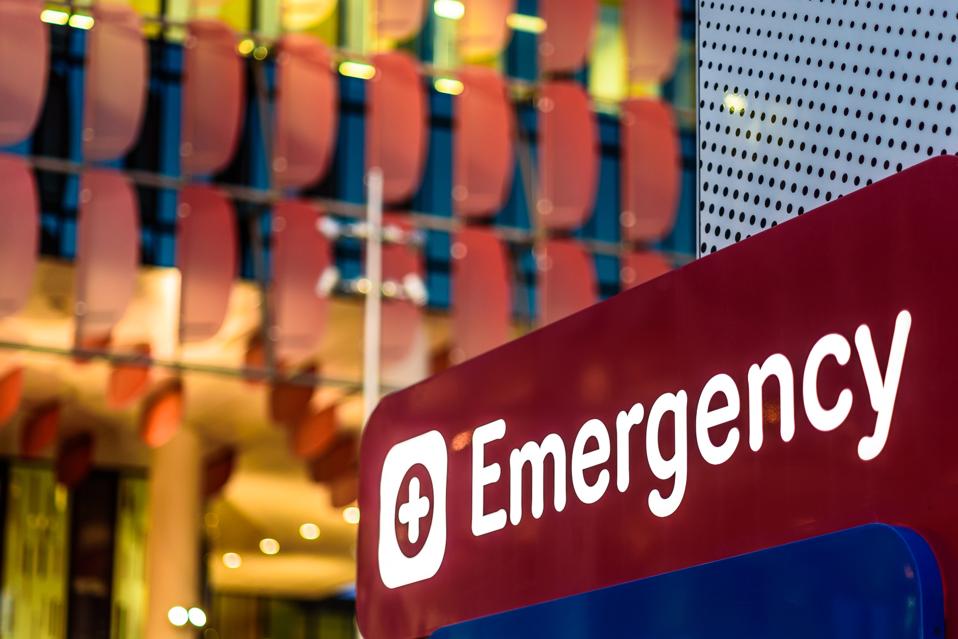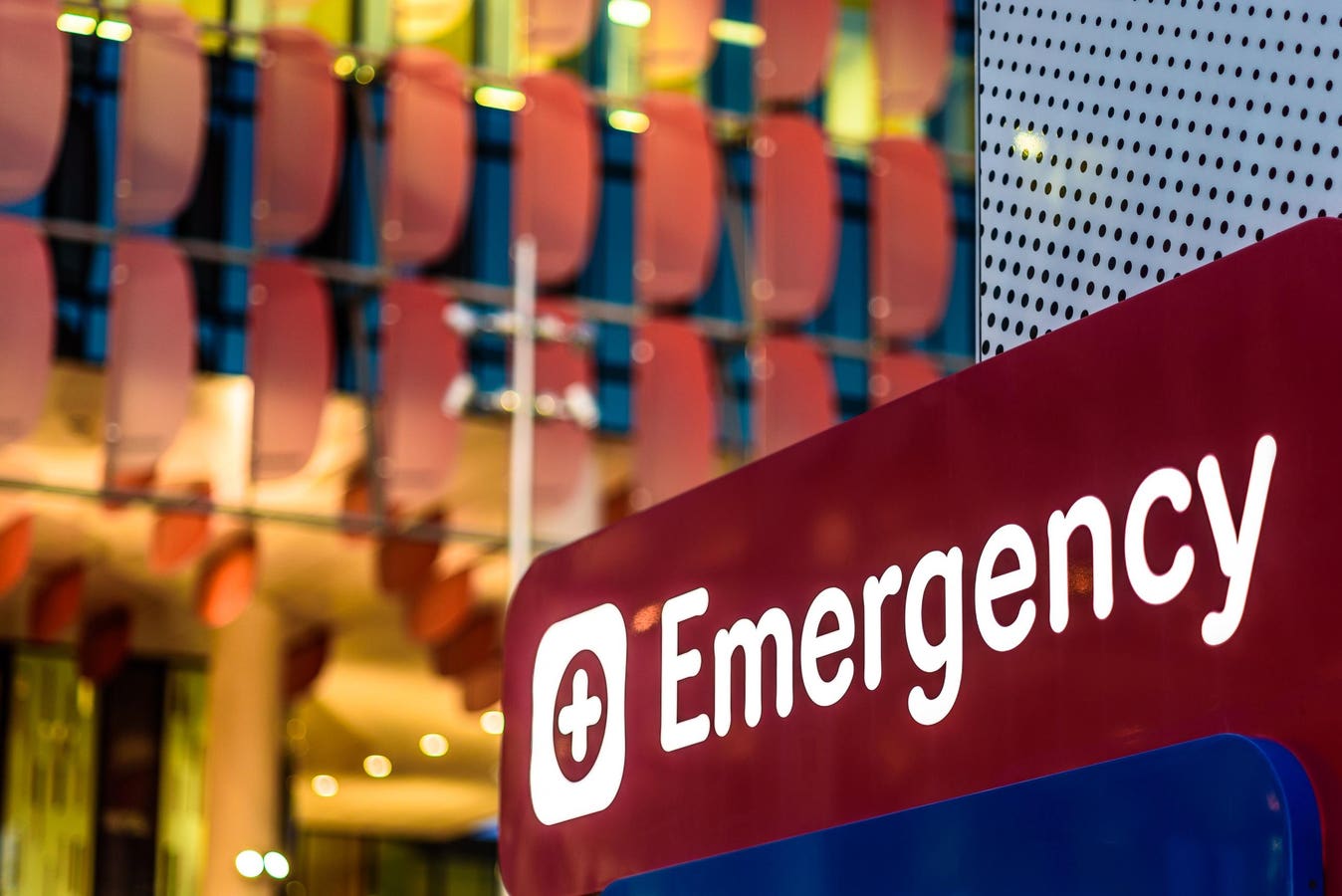
An “Emergency” Sign in front of a hospital in the early evening
getty
The American healthcare system is approaching a crisis. Medical costs are rising far faster than the nation’s ability to pay. Healthcare jobs are expanding rapidly, but clinical outcomes aren’t improving. And the very professionals entrusted with healing others are burned out with many leaving the field.
Each of these trends is alarming. Together, they signal something far more serious: a system speeding towards a cliff, with no off-ramp in sight.
The Warning Signs
Let’s start by examining the three most urgent warning signs, then turn to the more pressing question: Why are the exit ramps that once helped the U.S. avoid economic disaster now closed?
1. Healthcare costs are rising faster than the economy can sustain
The Centers for Medicare and Medicaid Services (CMS) recently reported that national health expenditures rose by 8.1% in 2024 and are expected to grow another 7.1% in 2025. By comparison, the U.S. economy is projected to expand at just 4.3%. At this pace, healthcare spending will consume 20.3% of U.S. GDP by 2033, up from 17.6% in 2023.
Although CMS predicts that cost inflation will slow to 5.6% in 2026, that decline won’t be due to increased productivity. Rather, it will be the consequence of millions of Americans losing Medicaid and Affordable Care Act coverage following passage of the “Big Beautiful Bill.”
Without insurance, people’s medical needs don’t simply disappear. Treating them just gets delayed, which is why costs are projected to rise in subsequent years.
2. Medical employment is booming while affordability crashes
In medicine, costs often fluctuate. But when the main driver is labor growth, those costs become structurally embedded and far harder to reverse.
Healthcare is now the largest employment sector in the country, surpassing even manufacturing and retail. One in three new U.S. jobs created last year came from the healthcare industry. Wages in the sector are rising, too, which puts even more pressure on overall spending.
Whether workforce growth stems from an aging population, worsening chronic disease or the growing power of large hospital systems, one thing is clear: greater employment isn’t translating to greater efficiency or superior clinical outcomes. And unless the underlying system changes, these forces will continue to push costs higher.
3. Doctors are struggling and sprinting toward the exit signs
One of the costliest and most-threatening labor trends in healthcare is the steady erosion of the physician workforce.
Private practice is vanishing. Just 42.2% of doctors remain independent today, down from more than 60% in 2012, with many becoming employees of large hospitals, health systems or insurance companies. At the same time, private equity ownership of physician groups has surged from 4.5% to 6.5% over the past two years.
Data demonstrate that when hospitals acquire a physician’s practice, prices and overall costs rise. Meanwhile, private equity firms often cut staff, increase caseloads and raise prices, which push physicians closer to burnout and patients farther from the care they need.
A growing number of physicians aren’t selling, they’re fleeing. Canada has reported a 750% increase in applications from U.S. doctors seeking licensure. In the U.S., 27% of practices say a physician retired or quit early last year due to burnout, while 35% of physicians are actively considering an exit.
Why The Exit Ramps Are Closed This Time
Rising costs, soaring employment and widespread physician dissatisfaction are not new to American healthcare. What’s different now is that the traditional escape routes (the exit ramps that once helped the nation avoid economic disaster), are no longer available.
What remains are three difficult realities that make a smooth detour all but impossible:
Government can’t keep borrowing
In the past, rising healthcare costs were absorbed through ever-expanding federal deficits. But with the national debt now at historic highs, and with annual interest payments ($950 billion) exceeding the total cost of Medicare ($850 billion/year), that exit ramp is closed.
More than 70 million Americans rely on Medicaid and another 60 million on Medicare. That’s nearly 40% of the U.S. population. Any major increase in healthcare spending would crowd out other federal priorities that lawmakers count on to maintain public support. And under current PAYGO rules, new spending would automatically trigger cuts to Medicare. Most elected officials would consider that outcome politically untenable. As a result, borrowing can no longer be relied upon to contain healthcare inflation.
Employers can’t shift costs anymore
For decades, companies handled rising healthcare costs by using money that traditionally would have gone toward higher wages to cover insurance, instead. But as the job market tightened and workers began demanding better pay, that strategy lost traction.
So, employers changed tactics. Instead of covering the full cost of care, they started shifting more of the burden to employees through high-deductible health plans. Many of them came with annual deductibles as high as $5,000 to $7,000. That meant workers had to pay thousands of dollars out of pocket before insurance kicked in. And because 80% of patients don’t spend that much on care each year, these plans reduced corporate insurance premiums.
But that strategy has also run its course. Today, nearly half of Americans say they’d need to borrow money to pay their out-of-pocket costs if they became severely ill or injured. Raising deductibles even higher isn’t sustainable.
Insurers and health systems can’t squeeze doctors further
A third way payers and insurers have been able to control costs is by increasing physician workloads and restricting access to care through prior authorization and claim denials. But this exit ramp is closing, too.
Physician pay has lagged behind inflation for years. One in four doctors now earn income outside of medicine, and nearly two-thirds of physicians in their 40s expect to retire before age 65.
Insurers can’t push physicians any harder — not with a projected shortage of 100,000 doctors, rising dissatisfaction in the workforce and growing scrutiny from Congress over insurance practices.
The Possible Paths: Options To Avoid Utter Collapse
As an instructor in both the medical and graduate business schools at Stanford, I understand how differently these two worlds approach uncertainty. In medicine, physicians require double-blind studies and statistical proof before acting. In business, leaders must make decisions based on probabilities and patterns, almost always without perfect data.
However, when all the evidence points clearly in one direction, change is inevitable. The growing economic crisis will transform American medicine. Whether the response comes from private industry, technological innovation or unfettered chaos, disruption will impact both the providers and recipients of medical care. Three paths lie ahead.
1. Private-equity-led cost cutting
In this scenario, for-profit companies (including insurers and private equity firms) lead the response by slashing costs. They acquire medical practices and hospitals, reduce staffing, eliminate unprofitable services and push doctors to limit tests, treatments and prescriptions.
If successful, this could shave $150 billion off the annual increase in healthcare spending. But the gains would come at a price: diminished patient and doctor satisfaction, reduced access to medical services, eroded trust and greater inequity.
2. Generative AI transformation
A more optimistic path would be powered by generative AI. Employers, facing unsustainable costs, would push for tools that automate administrative tasks, streamline diagnosis and improve chronic care management.
They’d recognize that if generative AI tools were implemented thoughtfully (with proper training, regulation and payment reforms), doctors could use the technology to prevent up to half of heart attacks, strokes and kidney failures through the better prevention and management of chronic disease.
In addition, clinicians could reduce misdiagnoses and preventable medical errors. Consequently, costs would fall not by care restriction, but by reducing the need for care in the first place and avoiding expensive complications when medical treatment is required.
3. Crisis-induced disruption
The most pessimistic and dangerous outcome is that our nation will sleepwalk into the emerging financial crisis. If no action is taken, economic strain could trigger a full-blown disaster: a deep recession, sweeping cuts to Medicare and Social Security, or federally imposed wage and price controls.
Healthcare would be rationed. Delays would grow. The medical mindset would shift from “what’s best for the patient” to “what can we afford?”
Each path might flatten the curve of medical inflation, but the consequences are vastly different. The first cuts spending through austerity. The second lowers demand by improving health. The third limits care by force.
For decades, health policy experts have told us what should happen. Now, the question is what will happen. If employers and clinicians lead the way, positive transformation is still possible. If government or corporate interests take the wheel, cost containment is likely to come at the expense of public health.
Which will occur is anyone’s guess. But one thing is for certain: healthcare soon won’t resemble its past or its present.

